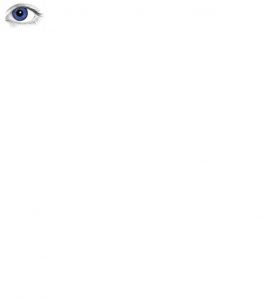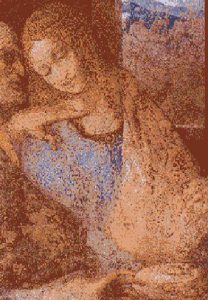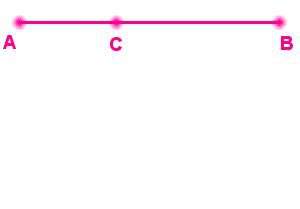That the brain seeks patterns is a well accepted fact by psychology and is also used against you in the search for truth, you will be aware of the so called ink blob test whereby you are asked to tell what you see in them. And researchers who seek answers either in paintings such as the last supper of Leonardo Da Vinci, geometric patterns such as those found on Mars, Rennes-le-Chateau, Giza and many others are at risk to see things in them which are not really there. So how can you be sure if what you recognize is really intentionally made to hide or contain something and not the brain recognizing something of itself? In previous articles it was explained that Mr. Bucket only has eyes for what it knows and that it uses your senses to seek of itself, it is therefore important to understand what seeing really is. The following is part of a book written by Derek Bair who did research into Da Vinci and his manuscripts and paintings. It will become clear that Leonardo Da Vinci’s knowledge went a lot further than you might have thought. I made some corrections and added some things to it with the intention to show that Da Vinci knew and used it. I have explained that the tree has its mirror image, but also how the mind will trick you into following its idea of the truth.
Perception is the organization of sensation. We sense light and colour and contrast with our eyes and then our brain turns those sensations into images in our minds which we call vision.
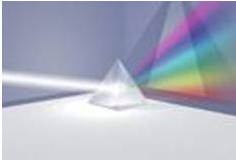
Also think of the Y of jod (Hebrew).
Our two eyes converging in pyramidal line of sight from two eyes to one object – the PERSPECTIVE. Our eyes will then focus on specifics and recognizable patterns, words, letters, symbols, faces – etc. But it’s when they are THOUGHT about that we start to perceive them.
Perception is how we use our senses. It’s the faculty that’s doing the understanding. Perspective is from where, who, or from what point the perception is taking place. What is the one true perspective? Is there one? Would it be the perspective of an unbiased observer? That’s what the concept of a universal God is – the one and only correct perspective and way to perceive the world. Everything perceives the same thing (the world) but perspective is the consciousness or vantage point of each individual. If you think of the quote, look at it from his point of view, the perspective would be the eyes of the person and their perception would be their mind doing the considering.
To better understand perceptions imagine opening your eyes after a night of very heavy drinking. Your mind starts to receive images after being unconscious for a while. It takes a while to figure out where you are and how you got there. Sometimes you won’t even notice a difference until that one instance – where the @%#@ am I?! What happened? Who are you?! – It’s in that very instance that you perceive. Up until that point you were seeing, and experiencing sensations but perception is that conscious awareness of the senses. It’s realizing you’re somewhere you don’t usually wake up. It’s caring about where you are and why you’re there.
Perception can be more than with just visual sensations. They can be from your sense of smell. Sniff Sniff “what’s that smell?” – ughhhh! There is that one point where you start to realize there is a difference and then once you start to think about what it is and then once you figure it out.
When you think about your own consciousness and try to figure out where it is. It seems like it’s in your eyes. But that wouldn’t be possible because you have two eyes but a single consciousness. So is it where the signals meet? At what point does your existence come into a point? – the soul. Is there a single spot in our brains that our soul resides? Or is that single spot the entire brain -the brain as a whole? The brain is the spot, the container for our minds? This wouldn’t be the case because you can have parts of your brain removed – up to half of your entire brain in some cases – and still not only be alive but be conscious. So it seems like we, our essence – our soul you could say isn’t a single spot but the combination of all the processes going on inside your head. It’s not in the left part of your brain, the right part, or a grouping of cells, it’s the whole divided down into as many parts that you could still be considered you.
Now consider Plato’s cave again, from where does the picture on the wall come? Then read : The life giver, and then read from the start again.
So what would describe the combination of all the mental processes and equipment that allows you to make conscious decisions. Not just the computers’ processor but all the equipment required for it to boot up?
Consider it like a bee hive. Each individual bee is alive, but it’s the entire hive that constitutes a whole. You could lose half of the population but it would still be a hive. You could lose everyone but the queen but then it might not be considered a hive anymore. The hardest thing to understand is finding a single spot of consciousness. It’s a struggle you all have. Are you just the sum of all parts – the ghost in the machine. OR are you a soul trapped in a vessel?
The eye, which is called the window to the soul, is the principal means by which the central sense can most completely and abundantly appreciate the infinite works of nature, and the ear is the second, which acquires dignity by hearing of the things the eye has seen. “If you, historians, or poets, or mathematicians had not seen things with your eyes you could not report of them in writing.” Plato.
The thing about the sense of vision is how intrusive it is. It dominates our other senses and in doing so dulls them down. Sometimes you have to close your eyes to fully appreciate any other sense. But let’s face it, it’s a visual world. To appreciate this planet we have to see it, not smell it, or taste it, or even hear it. So let’s understand how you see, so you will better understand what you see.
You perceive with all of your senses but let’s elaborate on the one you rely on the most: your sense of sight is nothing short of a miracle. Vision is a miracle that can be understood by science but which takes something of a grander sort to appreciate. The hand is quicker than the eye. The mind is quicker than the eye. The mind is quicker than the hand. Your eyes operate at the speed of 26 frames a second, which is faster than any hand. The mind is even faster.
Vision is such a vastly complicated thing that you are barely able to comprehend its presence. You see, of course, but you don’t really know how. You usually know what you see, but not how you see it.
In order to fully understand the structure of creation it’s important to understand how your eyes work. It’s a complex combination of a lot of things that you probably have not imagined before but obviously have experienced!
Tv and movies have desensitized you to the real world, but at the same time have also expanded your minds in ways that have never been possible until this point in time. They’ve dulled your senses but increased our perspectives. With the abundance of new perspectives comes the difficulty of knowing what the right perception of the world is.
Vision is a sense that is usually very seamless. You look, you see, you process – you perceive. Our brain turns two images from two different eyes into one.
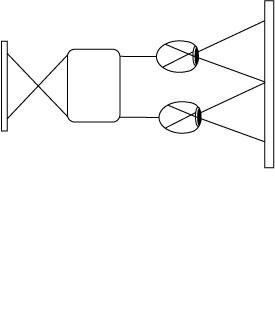
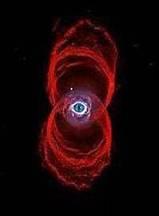
You don’t see the world as pictures or movies. You see the world in real time with perception and memories. It’s not just time that is relative but vision as well. You can see one image – once and for only seconds and remember it more vividly than our own faces.
Most people don’t truly understand the processes that go on behind their own eyes. They don’t realize that they’re seeing things in reverse and two images – not just one. It’s something you all take for granted and fear losing above all else. Da Vinci said, and I would have to agree -that we’ll protect our eyes before anything else. If something unknown starts to fly at us, it’s our eyes we cover even before our heart. Even though you die without it, it comes instinctually second to your eyes.
At the most basic level an eye is a device that detects light. It’s something almost every living thing can do, but all in slightly different ways because you all have slightly different eyes. It’s the Mantis Shrimp that has the most sophisticated colour vision system. Snails have one of the least. They don’t actually “see” but only sense the presence of light. They don’t know what colours or shapes are. A rattlesnake sees heat, dogs see only in black and white, and eagles can see even more clearly than you do. The sense of vision serves the same purpose but in different ways for each different individuals purpose. The level of sophistication for each set of eyes varies depending on what they need to see, to watch out for, or to notice.
As humans you use your eyes as your primary way to perceive the world so your vision is very sophisticated. The most amazing concept behind the human eyes isn’t the eyes themselves but the minds that use them.
To make something extremely complex – relatively simple this is how you see: first light enters your eye through the cornea which is the surface of your eye. Then it is directed into the rest of your eye by your pupil which dilates to allow the right amount of light into your eye. It opens wider to allow more in, and contracts to allow less in. After that the light is inverted and reflected to the back part of your eye that is filled with mini light sensors called rods and cones. These little sensors detect the differences in the light and go through a photochemical process that turns the light into chemical/electrical signals that then go to your brain for processing.
It’s like each rod or cone is a smoke detector that tells the system where the fire is, how bright it is, and the colour. This is how light is turned into an electrical signal your brain can “see”. You’re not actually seeing light at all, you’re not seeing anything at all. You’re discerning electrical signals. For example, in the near future you’ll be able to create artificial eyes or cameras that will be able to send information to a blind person’s brain. This shows how it’s not the actual eyes that are doing the “seeing” but are just sending electrical information. So imagine vision like a computer. Your eyes are cameras/web cams/the device that puts the pictures into the system. The camera itself doesn’t know what it’s seeing, it just sends information to the brain.
Then your video card is the faculty that detects the various colours in the image you’re adding to your system. Your video card detects how much red, green, and blue there is. It also determines the contrast between each of them and intensity. It basically turns light into electricity to be interpreted. After this is done it’s in the system but what happens next depends upon what its purpose for being there is. Are you trying to see a picture, read text, play a game, or looking for something? What are you looking for in the image you’re receiving?
Think about human vision as having two web cams that are constantly sending images into your computer. Then the user (your(sub) consciousness) decides what to do next. What do you notice? You can control the cameras to move and focus on different things or spaces in front of you. Each camera *eye* is directed to the same thing and where they focus is the tip of a pyramid. One way and there is another( the star of David being two pyramid’s.)
If you’re reading for instance, think about it like this;
1 2 3 4 5
Your eyes will look from each number to the next because you’re telling them too. It happens so fast you don’t think about it. So in this case you’re looking for the next number. In the case of this paragraph you know to look to the next word, then to the next sentence to look for the meaning. You’re always pretty much looking at the same space(this paragraph) but you change your focus from each word to the next. So it’s not like you’re only seeing one image(word) then the next but directing your FOCUS from one image to the next.
Your eyes are not directing you; you’re directing your eyes. Your subconscious is pretty much the thing that controls all the details. Your conscious is the faculty that you are currently perceiving, whether it be the faculty of reading, writing, listening, talking, or looking at a picture.
Some can be done at the same time, some require your full concentration. You can walk without thinking about it, or if you’re on a runway then it might be the only thing you’re thinking about. You might be singing without thinking about it while you’re in your car, or have it be the ONLY thing you’re thinking about when auditioning for American Idol. Your consciousness is the delegation of your focus- Where you place the relevance and your mental resources. Your subconscious takes care of the details. This is very relevant to vision because it is your main sensational input. But you also use your other senses at the same time.
Think of us as a computer with 5 different types of web cams or inputs. One for vision, one for taste, one for sounds, one for smell, and one for touch. Then there are various places in your brain that control each. It’s like having a different computer card for each of them that interprets, recognizes and sends that information needed or requested.
When you’re reading this, your sense of sight is being activated as well as the parts of your brain required to understand what I’m talking about. Your other senses might not be needed; this doesn’t mean they aren’t still taking information in, they’re just not relevant right then so they’re not keeping your focus.
Wehre is the huose of the suol is it in the haert or in the mnid? Did you notice you were able to read this? As long as the first and last letter of each word is in the right place.
If your phone were to ring RIGHT NOW, your sense of hearing wouldn’t be activated (it was already on) it’s just that something new is perceived and the part of your brain responsible for understanding that sense would become relevant and become the focus of your consciousness. Then you would activate yet another part of your brain to understand the person’s words. A different part would be needed to identify who they are, then yet another part when you have to think about an answer, and then yet ANOTHER when you speak that response. So it’s safe to say you can do a lot more than walk and talk at the same time.
You might have been listening to music, biting your nails, humming, and thinking while reading this. And at the same time digesting, adjusting your position for comfort, smoking etc.
Does it not make you wonder what your limit is. How many things can you concentrate on at once? They say that you can only think one thought at the same time, but that is just not true. Maybe you can only be conscious about one thought at one time but you are really having millions of them at every moment. Your controlling your breathing, what to listen to, and what to ignore, what you’re smelling, and what you’re not, what you’re sense of touch is feeling, and any taste in your mouth. Not to mention things you don’t even know about.
Basically vision is your eyes detecting the reflections of light of something and into our eyes. From there it turns the light into something your brains can work with.
The best part isn’t the eyes themselves but the brain and mind that understands them. Once the brain gets the information, how does it know what it is??
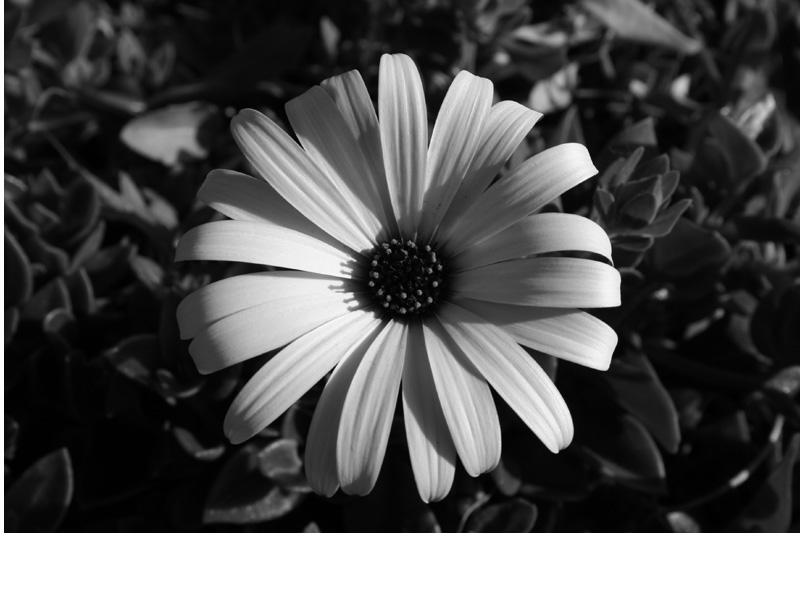
Consider the picture above to be the information that your eyes have sent to your brain. How do you know what it is?
There are many techniques you use to understand what we see – Most of which are related or dependent on each other. To know the size of something you need to know how far away it is, or how big it is in relation to something else. If you see a car, how do you know if it’s a model car or a real car? You would have to see something next to it for perspective. Or know how far away it is. If it’s only a foot away you would know if it’s a full sized car or a model car. But if it was a picture of one and you didn’t know the distance or anything else to compare it to you might not be able to tell.
Memory is an important aspect to vision. If you didn’t know/remember information you wouldn’t know what anything was. You could see it, but wouldn’t know what it was. When you see something like a flower, you know it’s a flower because you have memories of what flowers look like. You don’t have to know specifics, just relative shape and size and characteristics. Without your memories you would be lost.
In almost every way learning how to paint is like learning how to see. Take Da Vinci’s journals, a lot of which are written to the reader about how to paint, as a guide to understanding the world. Although you might think what he’s saying is about paintings, it’s really about life – most of which is based on vision –which is based on light. He teaches you how you see .
Da Vinci’s take on perspective in painting:
“The first thing in painting is that the objects it represents should appear in relief, and that the grounds surrounding them at different distances shall appear within the vertical plane of the foreground of the picture by means of the three branches of perspective, which are: the diminution in the distinctness of the forms of the objects; the diminution in their magnitude; and the diminution in their color. And of these three classes of perspective the first results from the structure of the eye, while the other two are caused by the atmosphere which intervenes between the eye and the objects seen by it. The second essential in painting Is appropriate action and due variety in the figures, so that the men may not all look like brothers.”
You might have a moment where you think, what the hell is he talking about?! It took a lot of reading, reflection, and thinking to understand. Remember after several times reading the articles and your ability to read it the way it was explained you started to see/understand, it took practice but then you finally started to see the bigger picture and understood.
And what Da Vinci is saying is what things should look like, they’re not flat -that they should appear in relief, like they are 3d. That the things around the object you’re painting(or seeing) is within view of the vertical plane of the foreground. Meaning that if something is in front of the object it will be below it, if it’s further away – behind it. Like if you’re looking into the distance and see mountains, they are above you or on the top of a photograph. (A river wouldn’t be above the mountains in the sky, they would be below the mountains since they are closer) The three branches of perspective are just the ways that our eyes judge distance.
Diminution in the distinctness of the form – The further away an object is, the more blurry it is. Diminution in magnitude is their size in relation to the surroundings; the further something from the observer, the smaller it is compared to its size up close. Third is the diminution in color – the color is brighter the closer it is, and more dull the further away it is. Of the three, the first is because of the actual structure of your eye. The further something is away from you, the harder it is to see its details. The other two are not because of the eye itself but because of the “stuff”/atmosphere in between the object and your eyes. The moisture in the air, the smog, the clouds, etc. The water in the sky makes colours appear to change – this is why the sky is blue. Due variety and appropriate action are just making sure you don’t paint the same things in the exact same way.
And that’s just one brief description of one short quote from his journals. He has thousands. This also shows how much you really have to know, before you can know more. You could sit and read the same thing over and over again but unless you know what the words mean you wouldn’t be able to figure it out. It’s the difference between remembering the definition of a word for a multiple choice test and writing an essay about what they mean – in your own words. Now try writing about it – it takes not just time but understanding everything that’s needed. Not only do you need the insights into art and painting and eyes and vision and colour, religion and science, you had to understand them enough to see the bigger picture.
Obviously colour plays a huge part in vision. But how do we see colour? How can you tell the difference? Being in a submarine and get deep enough, all the colours of your clothes change. They lose their intensity almost to black and white. Understand why. The whole idea of colours in general is strange if you think about it. That things look different because of how light is reflected off them? Then when you realize that you only see a certain range of colour and light makes things even more bizarre. What does life really look like anyways? What would it look like when seen with a combination of all the different types of sight?
There are only truly three colours. Red, Green, and Blue. You can perceive 7 million combinations which create separate colours but they are still only the combination of the three main colours. RGB
You will realize that most of life can be divided into three different things that can be represented by these colours. Red being Positive, the aggressor. Blue being the negative, the passive. And Green being the mediator, the thing that brings them together – the neutral. You can’t have the good and the bad without something to relate it too – usually you. It’s the conscious decision or the thing doing the comparing of two things.
You have rods and cones in our eyes. There are about 7 million cones in our retina. Each of them is sensitive to a different region of the colour range. 64 % Red, 32% Green, 2% Blue.
Recently they have been able to take the first pictures of the living human retina. These pictures revealed some very interesting findings. You don’t all see in the same way. There are different variations in the proportions of red green and blue receptors. This means that if you see the same picture as someone else, they’re going to physically see something slightly different. But somehow you all perceive the same thing – or so you assume. It’s like how everyone see’s something online a little different because you all have slightly different monitors, video cards, and settings on both. You’ve probably come across the frustrating experience of printing off pictures that look different than how they did on the computer.
When reading about the variety in cone sensitivity, that you all see in slightly different ways, not just because you all have different eyes but because you all have different minds, will also assist in understanding how the knowledge got lost.
How do we know if you all see the same things in the same way? Most people who are colour blind don’t even realize they are unless they’re tested or it becomes a problem. How do you know if you’re all really seeing the same thing? Maybe you need to ask each other – Do you see what I see? – More often because maybe you don’t.
Your eye’s main purpose is to sense light. You don’t actually see objects but the light that is reflected off of them. So when you’re reading this you’re not actually seeing anything but the light that’s being reflected off the page – the contrast between the white background and the black letters. If the letters were also white obviously you wouldn’t be able to see them.

The contrast between the letters and the background is almost the same. You’ll notice how much more difficult it is to perceive the letters actually being there vs. how easy it is when the letters were white. You might also notice that as you look at one side of the rectangle the letters appear to disappear and blend in with the background. This is because you have a concentration of cones in a certain place in your vision. What you see where your eyes are focused (both of them together, and separate) is different than what you see out of the “corner of our eye”
As you’re reading this notice how much you can see outside the page. Without moving your eyes or focus or head – how big of a space are you really taking in? Move your hands out as if you’re doing a jumping jack – how far can you spread them until they are outside your range of sight? Move them in and away till you can perceive your range. Isn’t it interesting to notice, to become aware, of how much you are really seeing? That although you’re only usually noticing one specific thing, you’re really seeing so much more than that?
Another thing to consider which you can expand upon to your advantage is speed reading. It has everything to do with vision and your perception. As you’re reading this you’re probably going from one or two words to the next. If you can remember learning how to read you probably remember how you’ve evolved from going from sounding out each letter in a word to recognizing the whole thing. But as you’re able to recognize words as whole units you can go from reading letters to whole words. Instead of going from letter to letter you go from word to word. Then eventually some will go from words to sentences.
Read this sentence.
This is short.
This is easy.
This could be read in one “chunk” of information. How many 0’s are in each line?
00000000000000000
000000000000
0000
000
00
0
You probably have to count how many o’s are in the first line, but as they get smaller you just recognize oooo is 4 ooo is 3 oo is 2 o is one. You can teach yourself to be able to recognize numbers as patterns. E.g. You’d be able to recognize bigger chunks of information at once. Do you remember the film Rainman?
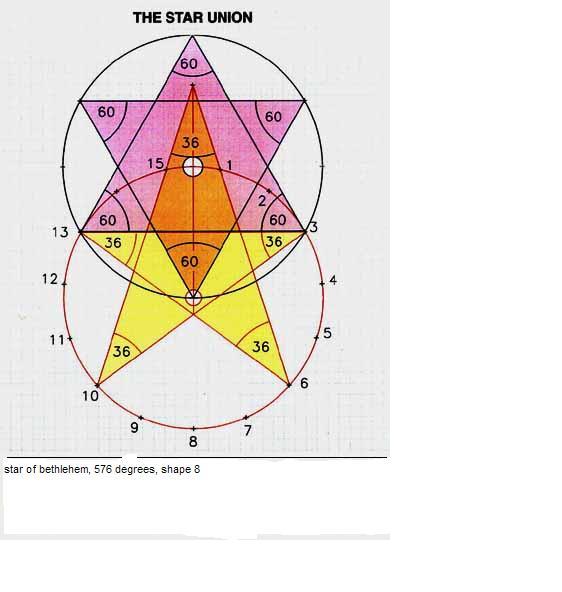
You can instantly, in one glance, get a lot of information from this picture. Maybe not a thousand words per say, but a lot. You could get even more if it were in colour. You don’t have to go from line to line – you see it as one image. If you looked at it once and had to close your eyes and describe it you could. Now if you think about this paragraph in the same way – that it’s taking up the same amount of space – why can’t you do the same?
Actually you could. You just haven’t learned how. You were taught to read one word at a time and probably haven’t tried to expand on that. Speed reading is teaching yourself to read bigger chunks of information at a time. Instead of going word by word you learn to see and read the whole paragraph. After all you’re still able to see it in its entirety; it just requires time to go word to word. Once you’re able to break that habit you can read things a lot faster. You also have to learn to not “say” the words subconsciously with your vocal chords. Usually when you read you’ll say them with your mouth – it’s very hard to stop. You learned to read that way. It would be beneficial to teach this type of reading at a young age to avoid the difficulties of breaking those bad habits later in life. They slow you down a lot. You probably still have to sing the alphabet song most of the time, and would need to re-learn it without the song! The first way you learn something embeds it deeper in your mind. That goes for all kinds of things! Religion, perception, spelling, math, etc.
In short, you could try to teach yourself to see pages of words instead of reading one word at a time.
The next way you decipher what you see is: Distance.
Distance can be relatively difficult to judge. You’ve probably found it hard to guess exactly how far away something can be. “Oh it’s about 3 blocks” Or it’s “just around the corner” Distance is measured in all kinds of ways; miles, centimeters, hands, feet, inches, etc. It doesn’t really matter what you call it as long as the distance is understood. For example the space between A to B. A………………..B
the 20 dots is the unit of measurement. Looking at this example it’s easy to determine the distance between A and B because you can see each dot/ period. BUT the units can be of varying distances. In the next examples you’ll see what is meant.
There are still 20 units between A and B but the distances are different. One is about 2 cm, and the other is 200 cm. But how could you know for sure without being there? You use your memory to “guesstamate” from what you can remember about the size of a flower.
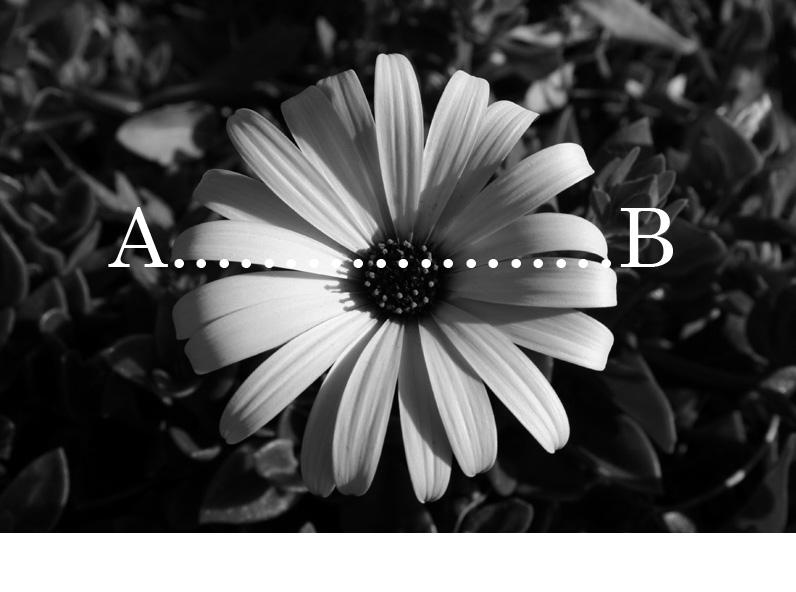
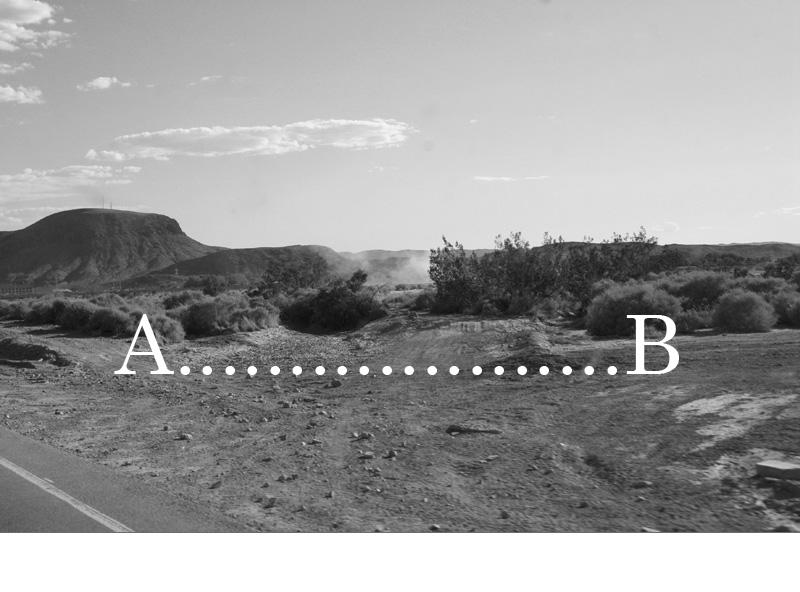
Although it takes up the same distance on this page, in each photo the distance between A and B very different. Also consider how the Distance between A and B would change depending on which part of the picture they’re placed. The higher up and the further away from the camera – the more distance between them.
Something significant to consider from this is trying to improve this aspect of vision within yourself. If you were asked how long a meter is, you could get pretty close. But anything shorter or longer than that would require more knowledge. It’s definitely within your abilities to gauge distance with uncanny accuracy, but it’s a skill you need to work on. A lot of people will only understand distance as it relates to something else. A football field, a car, how far the grocery store is. It’s something very good to develop as it will come in handy very often throughout your life.
It also shows how important memory is in relation to distance. You have to remember relative sizes of things to know how far away they are if you aren’t given any other information. If you’re looking at something in real life (as opposed to a picture) then you can gauge the distance by how far away it is from you.
Colour is also related to distance. The further away something is the less colourful it will be. Shape is also related because it becomes less conspicuous the further away it is. As said these are related and somewhat dependent on each other – they work together.
SHAPE:
It’s not surprising that shapes are the staple of early education, they are the staple of vision. We know a lot about something based on its shape. They can be simple;
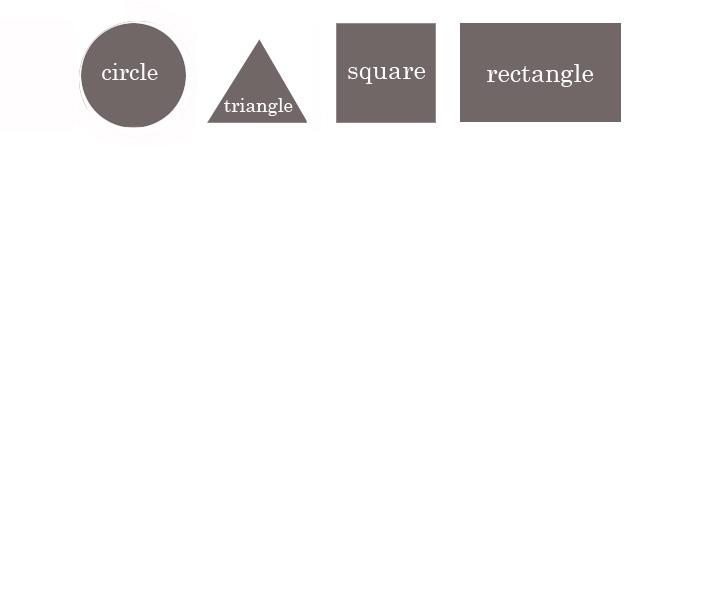
Or more complex:
Although you recognize the picture to be of an eye, it’s only because you remember what shapes make up an eye. You’ll notice that within more complex shapes are more simple ones. In an eye there are circles within circles. Your brains look for and recognize shapes, although you have to learn the names for the various shapes – you know what they are almost instinctually. A baby can recognize what a face is, what eyes are, and smile without ever being taught. How?
There comes a time when geometry is not enough and we graduate to symbols.
Symbols are very complex but easily recognizable shapes.
A B C E D F G H I J K L M N O P Q R S T U V W X Y Z
1 2 3 4 5 6 7 8 9 10 11 12 13 14 15 16 17 18 19 20 21 22 23 24 25
Letters and numbers are both just shapes, but shapes with meaning. A circle by itself might not hold any significant meaning, but a ring would.

Although all of the above could be considered to be circles, each can also have a separate meaning. A moon, a ring, a bowling ball, a face, a zero, or an O. How can you tell the difference?Symbols are shapes that represent a meaning. These are obviously dependent on your memory. You might not know the symbol of a bowling bowl if you’ve never seen one.
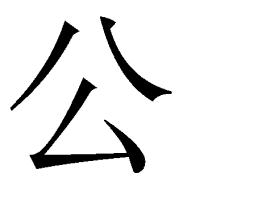
To someone who doesn’t know Chinese, the above just looks like squiggles. It really means “Calmness” Although you know what Calmness is, you don’t recognize it in Chinese. You don’t have a single symbol for it, we have 8 letters which makes a single symbol. It’s pretty amazing if you think about it.
The greatest example of this is this sentence itself. Each letter is just a shape that represents a letter. Each word is a combination of shapes to represent a single meaning. Each sentence is a combination of words to represent a combined meaning. It’s memory that plays the biggest role in our vision – again, without it you would be/feel lost.
Here are a couple exercises to get you seeing.

Blind Spot:
Close your left eye and focus on the square with your right eye. Move your head closer and then away from the shape until the circle disappears. Do the same with your left eye as you look at the circle. You’ll see (or not see) the other shape seems to disappear. This is called your blind spot. It happens because of a small absence of rods and cones in the place where your optic nerve is connected to your eye. You might also find it curious that you don’t notice this blind spot normally. You have a little spot in your field of view that is blank but somehow your brain just fills it in subconsciously.
Try this: Close your eyes and try to think about what your very own face looks like. Can you do it? Why, or why not? Go look in the mirror. Then do it again. It’s almost like our sense of vision becomes desensitized just as much as our sense of smell. If you see the same things for so long you start to think of it differently. What’s visually stunning to one person would be boring to someone who has to see it every day. A compelling image is one that doesn’t get old, it’s timeless and it’s something you can look at without getting bored.
The Holy grail/star of Bethlehem, the tree of knowledge is one of the best examples of this ever created. It’s captivating – not because of its beauty but because of what our eyes can’t see or perceive- The information that your brains aren’t fully capable of realizing(you can’t know what you don’t know). Almost how you can’t control how you transfer and store images our eyes process. Again -Vision is linked to memory very closely. What would your vision be without the memories, we have to understand what we see? That’s what perception is, our abilities to comprehend what our senses and memory are putting together.
Now that you roughly understand the physical dynamics behind what you see it’s time to put things into perspective.
Sometimes what you see and what you think you saw are two totally different things. If you don’t have a memory – or can’t understand an image that you’re seeing – it’s hard to remember or comprehend what you’ve seen. It’s why someone who’s never seen a goat might think it’s a dog until they perceive the differences. This will explain a lot of ghost and ufo sightings. If you don’t have an idea of what something might be, you’ll just assume it’s something you do know. A bear standing on two legs might be mistaken for a yeti. A reflection off a cloud might be considered an alien space ship. Remember that UFO doesn’t mean “aliens” it means Unidentifiable Flying Object. It’s just a word to describe something that no one could figure out what it really was. UFO’s definitely exist – the real question is why can’t they be identified? They have hundreds of accounts from military and reputable sources that verify the phenomena. Things flying around. The question isn’t if but what, all is conscious !
Leonardo Da Vinci fine-tuned his vision. He was able to see things you can only imagine. But realize it takes much more than this to be able to gain the eyes needed to see the whole.
It will remind you of the different stages of growing up. You’re able to perceive things differently as you get older( this does not mean better). When you roll a ball under a baby’s crib it will think that it has “disappeared” but eventually as their perception of the world increases they’ll understand that it just rolled underneath. Babies can’t perceive “under” until a certain point of their development.
There are very different levels of perception very few people have ever tried to develop like Da Vinci did. The ability to draw, to paint, to mentally come up with new ideas – creativity. If you think about the stages of growing up and how differently you perceive the world at different ages (perspectives) then it makes you wonder if there is a limit – or more importantly if you’ve reached it. That’s why it’s important to keep learning and bettering yourself. You should be constantly trying to reach a new perspective until you reach the ultimate, death, and you no longer have a choice.
With this structure he was able to trick our eyes into seeing things that you didn’t know were there and hide it in what is there. And in his paintings he did this too, it’s in the shading and how your eyes are looking at it. You know those pictures you can blur your eyes at and things pop out? It’s the same idea – as you un-focus your eyes they’ll refocus on new images! That’s why it’s so hard to agree on what you see in them, they change the more you look at them. There are certain clusters of rods and cones that give you better focus – where you focus. Try staring at the Mona Lisa – she will change and seem to move as if she’s alive.
Here are some exercises you can do that will help you train your eyes.
Crossing Training:
You can start by slowly crossing your eyes and trying to control how fast they cross. Stopping, going slower and faster, and then uncrossing (diverging) as well. Be careful it can strain your eyes muscles if you’ve never done it before. Only do it for very short periods at a time and work your way up!

Try crossing different dots in different ways and then going back.
Dilation Training:
This is easiest to do in a mirror. It’s basically blurring your vision. The sensation is like crossing your eyes but only slightly – enough to blur them but not cause them to cross. What’s happening is that you’re focusing on something that isn’t there -at various distances from the front of your face. (also try looking at something but put your point of focus past the object )
Hold your finger in front of your face at arm’s length and then bring it close to your nose while keeping your focus on the tip of your finger. You’ll notice that the “background” of your field of view doubles, but your finger stays as one until a certain point in front of your face – about a cm in front of your nose. Then you see two. The goal is to do this same thing but without the finger there.
Your eyes are just focusing at different distances in front of you but not necessarily dilating. To work on the dilation it’s best to work on one eye at a time. Cover one eye with your hand and then try to get your vision to blur. It’s the same sensation as crossing your eyes. So as you have one eye covered try to cross your eyes but without letting them cross – the goal is to keep the eye itself from “Crossing” or moving, but your vision to blur. Soon you’ll be able to blur your eyes without crossing them.
The next step is to get really close to a mirror and look at your pupil. Then try the same thing and watch your pupil get smaller and bigger. You’ll eventually be able to control it! It can be very irritating and frustrating the first couple times, it takes a lot of practice. Basically just stare at one of your pupils in the mirror and try to make it get bigger and smaller. You have to learn to recognize the particular sensation/ feeling that controls them.
Stereo Pairs.
These are called “Stereo Pairs” created by Derek Bair. They’re created by taking a picture and then taking another one with a slight shift to the left or the right about the distance between each eye. He would look through the lens and inside his camera are focus points – he would keep his head still, take the picture with the camera through one eye. Then without moving, move the camera to his other eye and make sure the center focus was in the same spot and take another picture. The result are two images that are very similar but different enough to enable your brain to process them as 3-dimentional.

This is what it looks like with both images combined together with a computer. Where it’s blurry is where they are different from each other. Your brain takes those areas and perceives them at different depths – thus you see them in 3d! Think about it. It shows why you see the world in 3d and enables you to see depth. This is also why sometimes people who are blind in one eye are not allowed to drive. They don’t know how far things are in front of them.



Cross the two images into one and they’ll turn 3d.
“Here [in the eye] forms, here colors, here the character of every part of the universe are concentrated to a point; and that point is so marvelous a thing … Oh! marvelous, O stupendous Necessity–by thy laws thou dost compel every effect to be the direct result of its cause, by the shortest path. These [indeed] are miracles;…
In so small a space it can be reproduced and rearranged in its whole expanse. Describe in your anatomy what proportion there is between the diameters of all the images in the eye and the distance from them of the crystalline lens. “
STEREOGRAMS.
It’s those who have to overcome a problem, that helps differentiate themselves from everyone else. When there isn’t a problem to overcome, people usually don’t even think about it. It’s those who have difficulty with something, who have to understand it better than everyone else who truly “know” something. Rembrandt had a lazy eye. This disability and making up for it led to one of the greatest painters who has ever lived.
It wasn’t someone who saw in a better way than everyone else that discovered 3d, it was someone who could not that did. In his quest to understand something he could not perceive, he discovered someone new. Stereogram’s weren’t “invented” (or noticed) until 1838. Charles Wheatstone figured them out when he was trying to describe binocular depth perception. The distance between each eye -It’s why we see in “3d.”
Da Vinci was completely aware of this phenomenon. And used it with this picture.

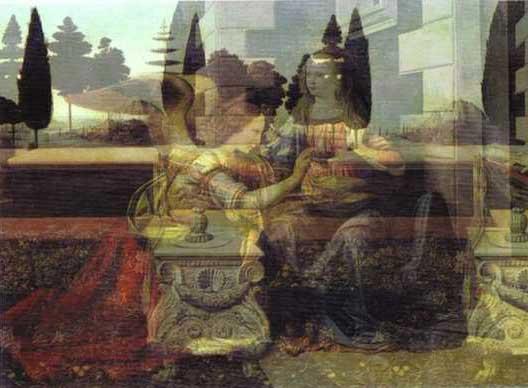
Think of it like a stereo pair, but within one single image.
It’s interesting because this painting which is called the “Annunciation” depicts the biblical scene of an angel telling Mary she will give birth to Jesus. So the hand on the belly is more than a simple coincidence. If you do it with your eyes (instead of with a computer) it actually works better and you can see that it was designed to be viewed this way. The angels hand actually appears to move when it gets near the belly.
This was found independently by Derek Bair and was known among those who were initiates .. Anytime you see something that is parallel to something else – then you might be surprised what happens when you cross your eyes.
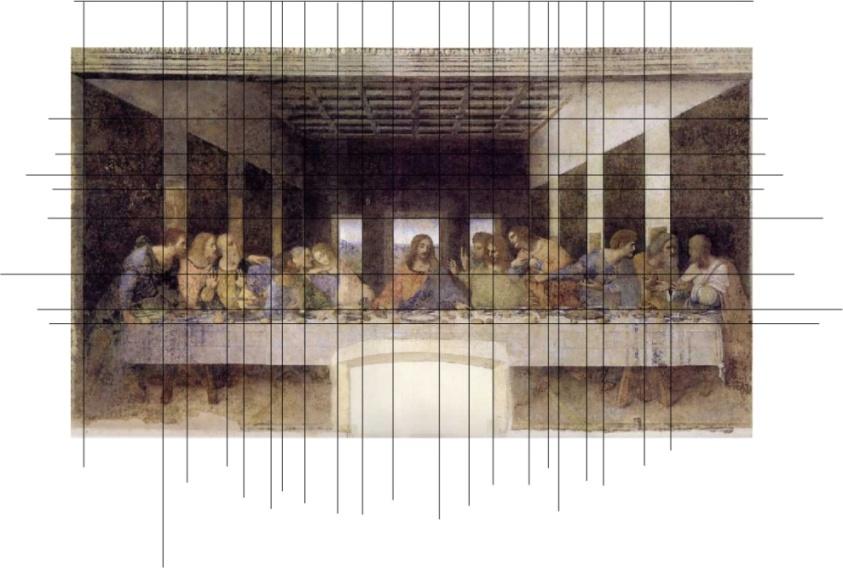
THE LAST SUPPER
Considered the second most famous painting in the world; The Last Supper, is a prime example of this eye crossing technique. It’s worthy of its own book but I’ll at least demonstrate what I’ve found. Interestingly it supports what Dan Brown was getting at in his book ‘The Da Vinci Code’. What I present next is what is being displayed in a PAINTING which only really demonstrates the opinion of the original artist- Leonardo Da Vinci.
Did Da Vinci know for sure that Jesus had a wife and child or was it just his opinion? That is for others to figure out. I don’t want to get into that with this book. The only thing I’ll say about it beyond what’s being shown in Da Vinci’s art is that he was a very wise man and intent on truth – not lies. Would it matter if Jesus was married and had a child? Does that make him any less of a person or more of one? Was he really the son of man or the son of a God? He claimed both. The only thing I know about Jesus for sure is that he has helped the world realize that love and forgiveness and compassion are more important than anything else. His message was true and clear but the details about his life are not. Especially the first 30 years – pretty convenient.
The Last Supper cannot be fully seen without crossing your eyes. Both mirrored and not. Once you do you’ll see the painting almost come to life as an animation. Although some might argue that this is just coincidence I assure you it is not. This is a clue that Da Vinci intended for this painting to be viewed by crossing your eyes;
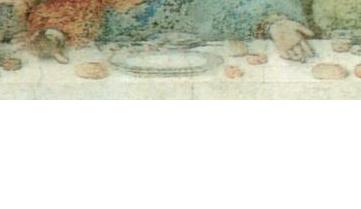
You’ll see by the hand expression that it’s like he’s taking the bread from one spot and moving it to the next. This alludes to what you have to do with your eyes. It also explains the hand that is holding a knife which has no apparent body attached to it. There is also a drawing Da Vinci made when preparing for this painting that shows a set of fingers walking across the table.
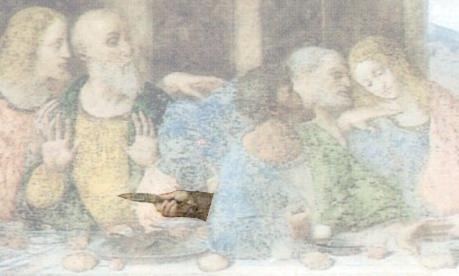
It would be difficult to explain at the moment without spending hours analyzing each “frame” the crossing makes. This will be saved for another book but so far I’ve confirmed that the person sitting next to Jesus is a woman and has a child – at least in the context of this painting.
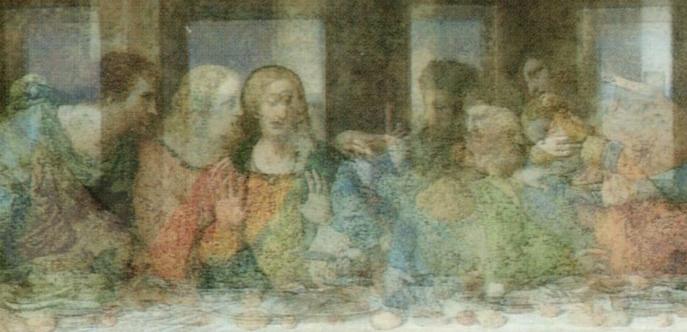
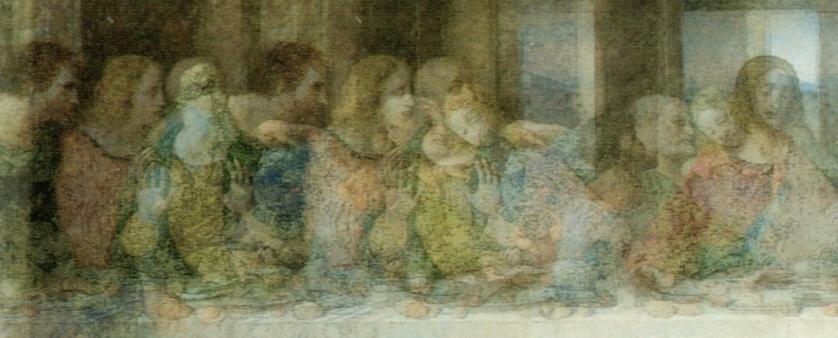
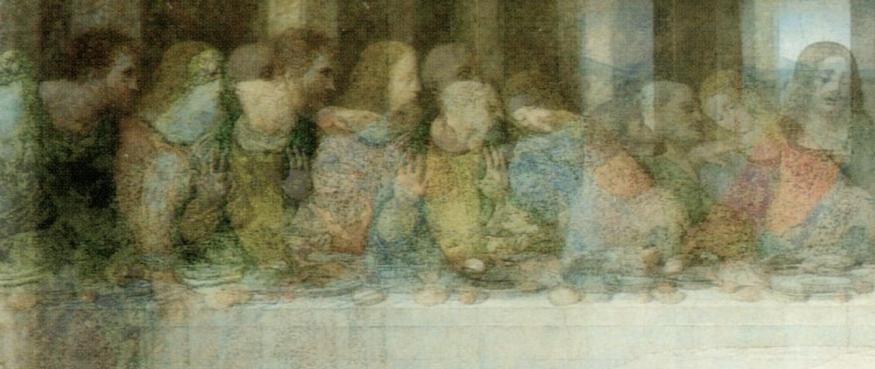
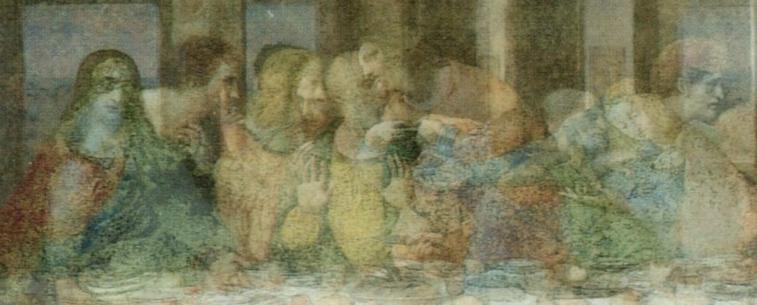
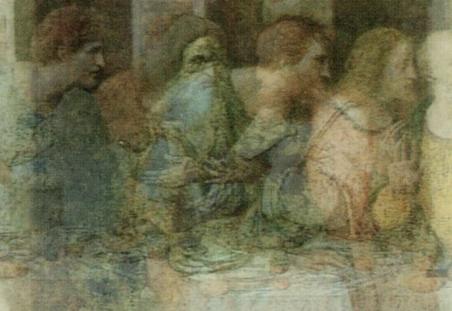
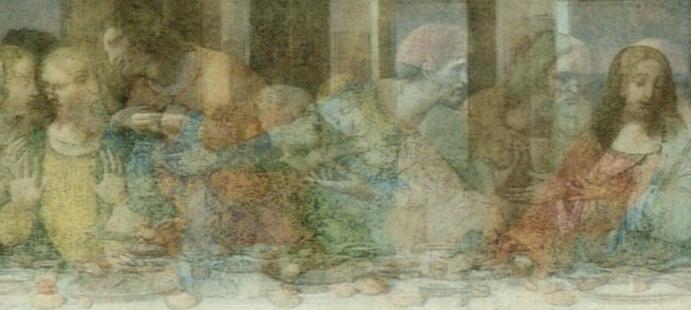
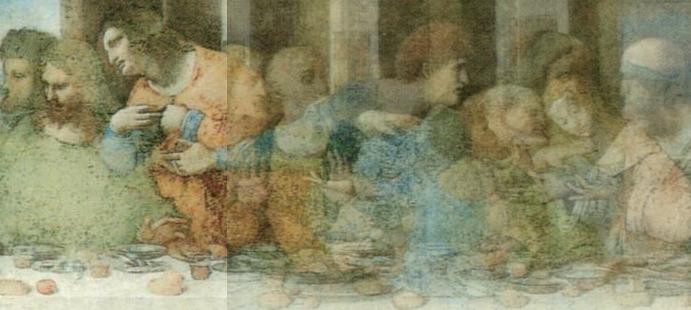
It’s difficult to see at these sizes but as the painting is crossed over on itself the characters appear to be passing and holding a baby. There are very distinctive hand positions to holding a baby and these appear in front of “Mary” and the other characters.
As the painting crosses itself the characters combine and form new facial expressions and even form new people. The green tie on the character on the far left combines over the faces of many of the others and creates a mask. That was the first thing I noticed when trying this technique. Like I said it would take hours of examination and knowing the story behind each character and knowledge of the Bible and this scene I don’t have.
Some things I have noticed that no one seems to have (even Mr. Brown) which seemed fairly obvious are these;
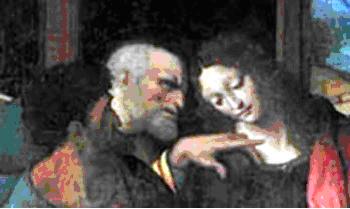
In this copy of the painting you might notice that the hand isn’t gesturing threateningly as some might think but it’s actually pulling back the shirt and pointing to where the characters Adams apple would be. Why? There is also a shaded indentation where the Adams apple “Should” be as well.
The face of this character also matches up with the face of Mary from Da Vinci’s painting “Virgin on the Rocks”

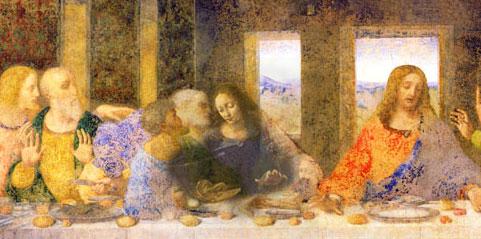
And curiously both faces appear to be looking down at a baby. In the virgin on the rocks she definitely is. And you might notice it’s the same expression in The Last Supper. They also have the expression you’d expect of a mother looking at her baby.. Remember how I said there were only 3 colours? RGB, and that they are symbols for Positive, Negative, and Neutral. You’ll notice the red and blue contrast with Jesus’s clothes and the person to his right. Where “She” is looking down is, Green. Green is the colour that represents a baby, the red being the father, and blue – the mother.
Again these are just observations from a painting and not real life. I have no doubt that Da Vinci intended and designed for the painting to show this but whether it is true or not isn’t my prerogative.
The painting started to fall apart before Da Vinci died and the details are almost completely lost. The main themes are intact and can be seen when you cross the painting on itself but the slight details that would have told the story better are barely there and were restored by other artists. I’ll leave this for another book and for people who wish to pursue it further. It requires both a change of perspective and perception to appreciate. How did he do it? That is Genius! I also think this demonstrates he was able to mirror an image on itself in his mind – it’s definitely not impossible.
Even more intriguing isn’t what happens when you cross your eyes within the painting itself but what happens when you combine the painting with its mirrored form.
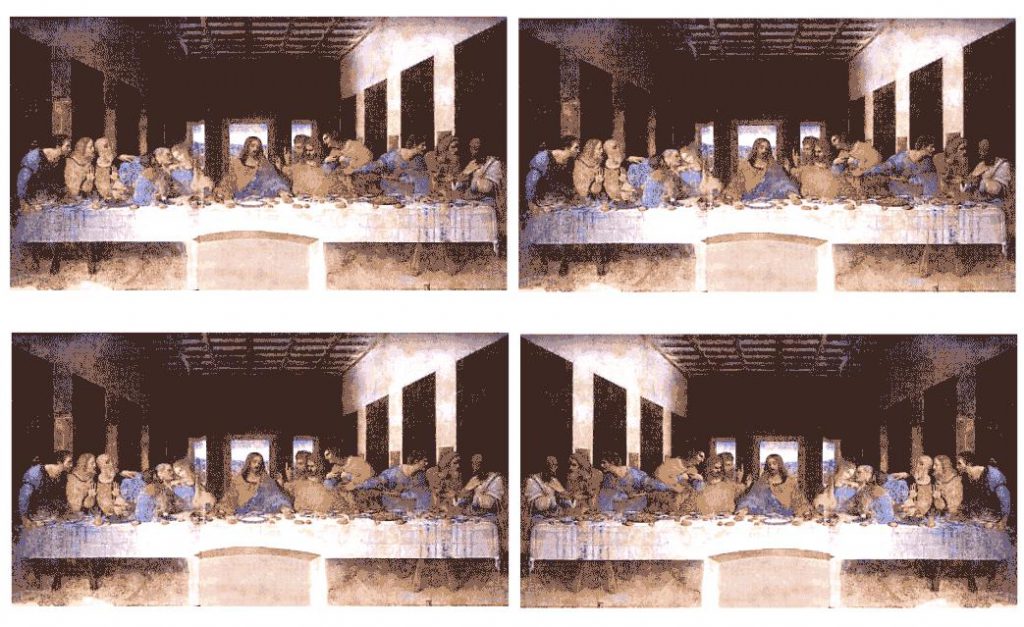
The top two are the same image. As you combine them with your eyes (by crossing them) it will cause one version of events – an animation. You can also cross your eyes from within one copy of the painting by crossing from one side of the table to the other. – When you cross the second set of images which is the last supper and a mirrored version of the last supper it creates a different more abstract animation which is entirely different. Just imagine the immense planning and brain power required to both think of this, and then execute it – wall sized no less.. There is also another clue within the painting hinting at it being viewed yet another way. There is a cup on its side on the walls within the painting. I believe this is there to make you think of doing what I’m about to show you. First turning the painting into a square. Then rotating it 90 degrees. You’ll see what look to be cartoons going from the center to the top as if being viewed from the top of stairs. Each step being the next step in a series of the “cartoon.”
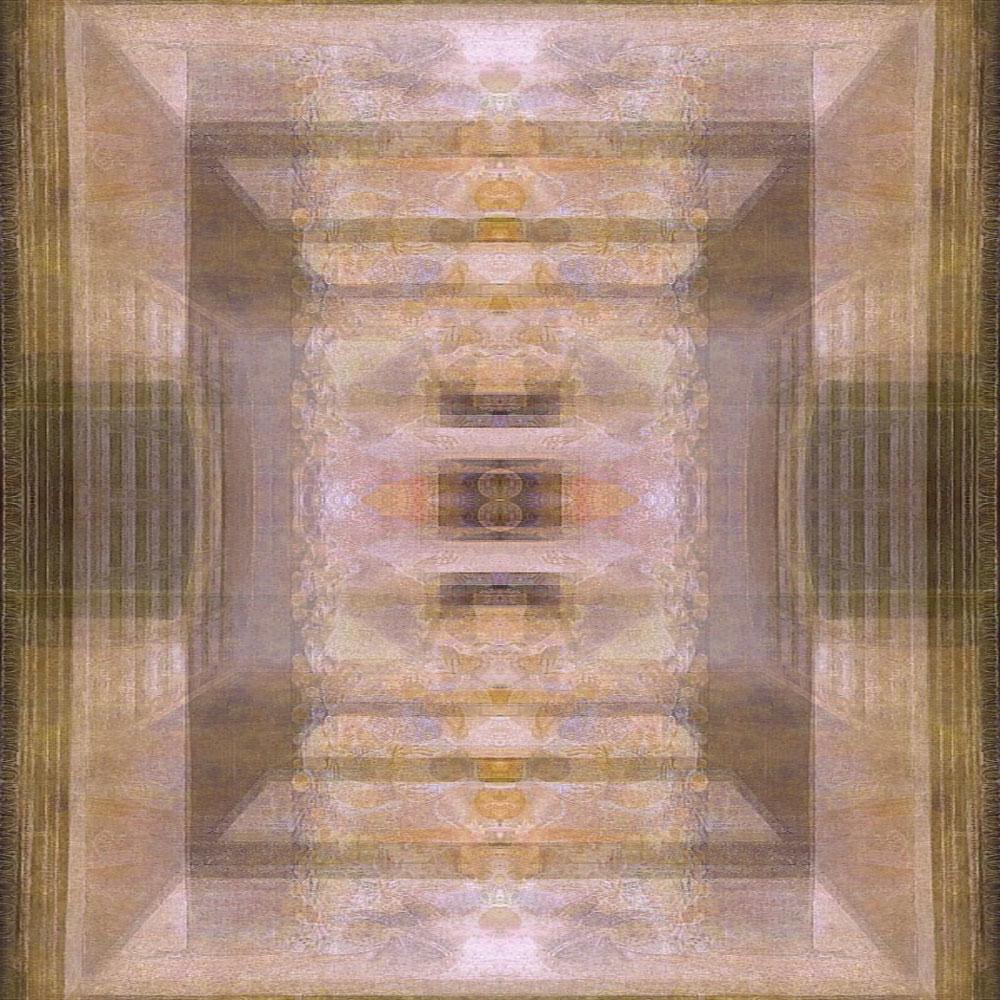
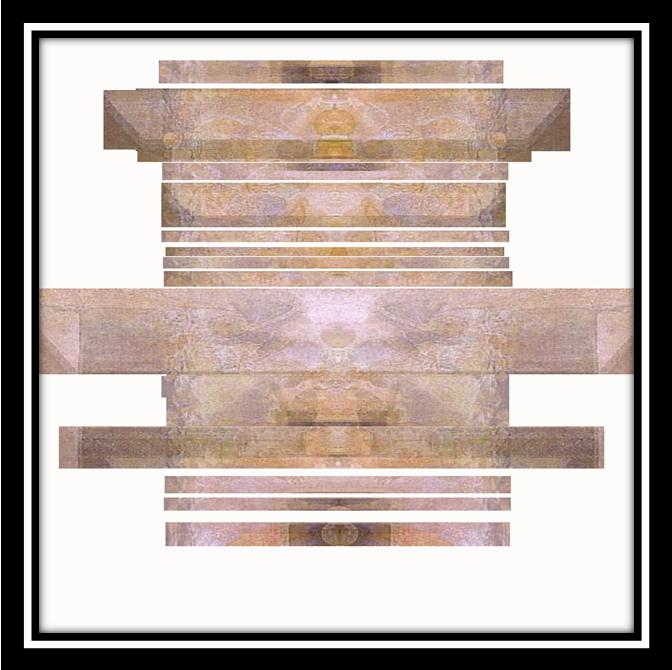
Here I’ve separated some of the steps. In the image on the next page you can see Jesus holding a baby over his shoulder. Once I can figure out exactly how to process this I guarantee it will make an animation!
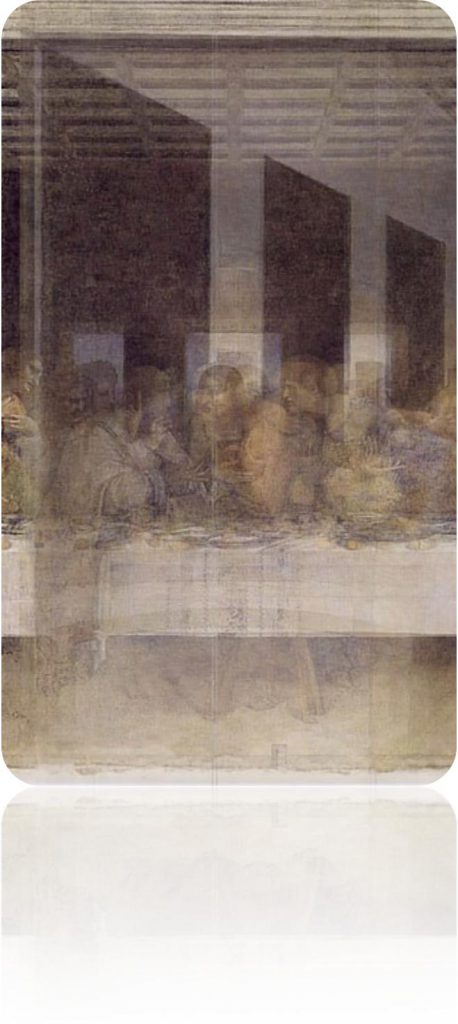
I call this one the “Great Ape”
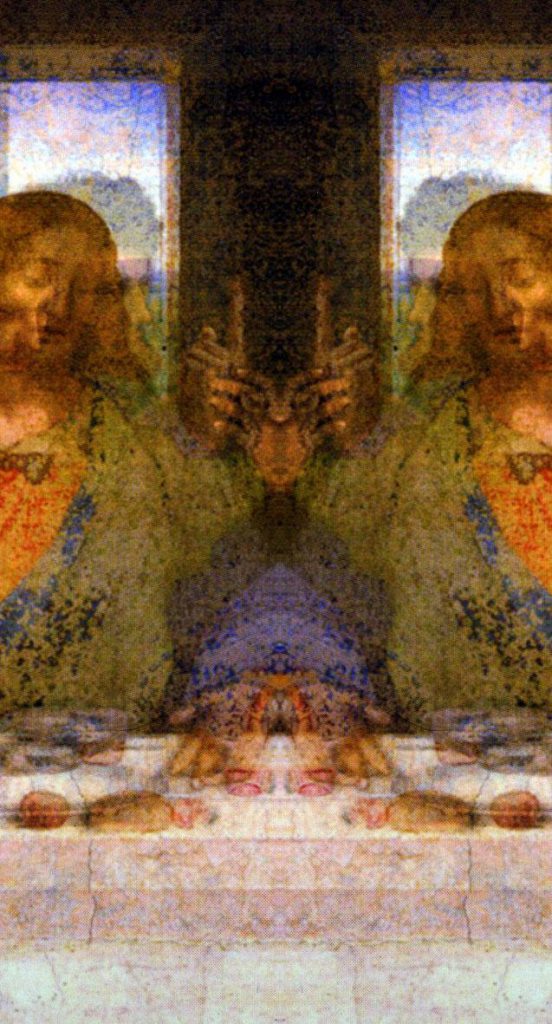
Looking for the missing “Chalice” ?
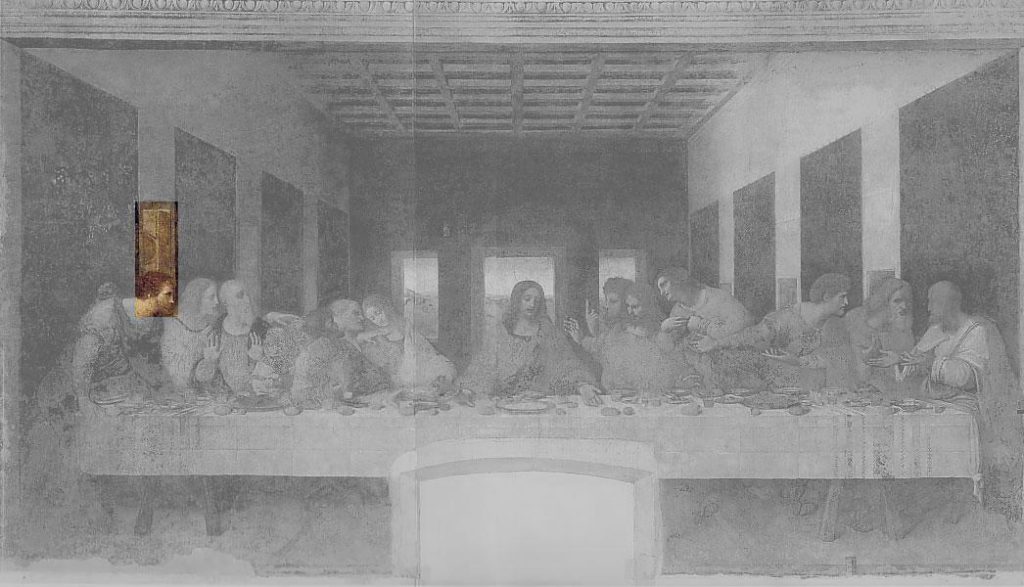
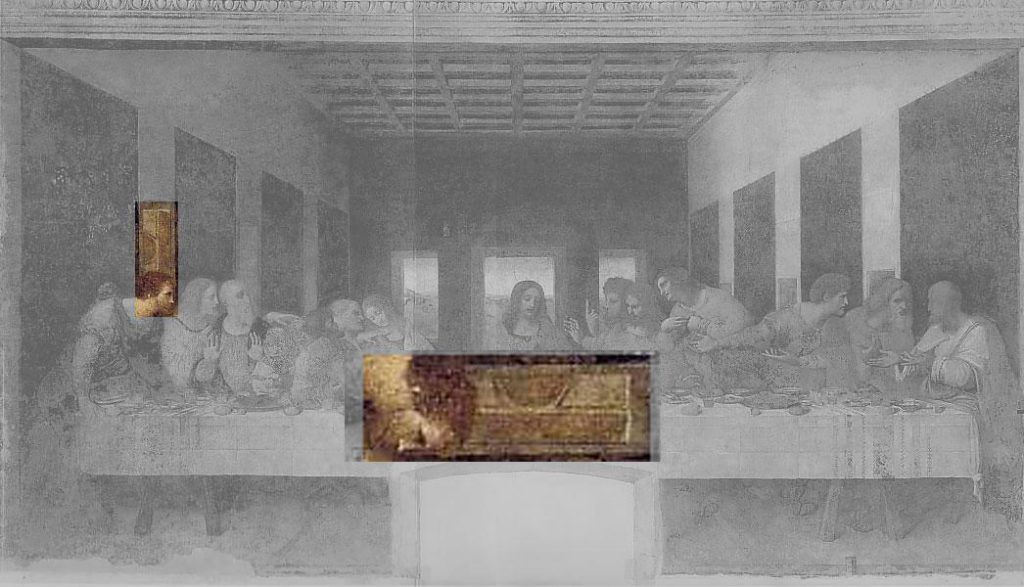
Notice the cup on the wall to the far left. It’s only one clue that alludes that this painting needs to be looked at from a new perspective!
None of the images are fabricated. They can all be reproduced by anyone with even slight photo manipulation knowledge. I’m guessing the technique was designed to be viewed with the naked eye though.
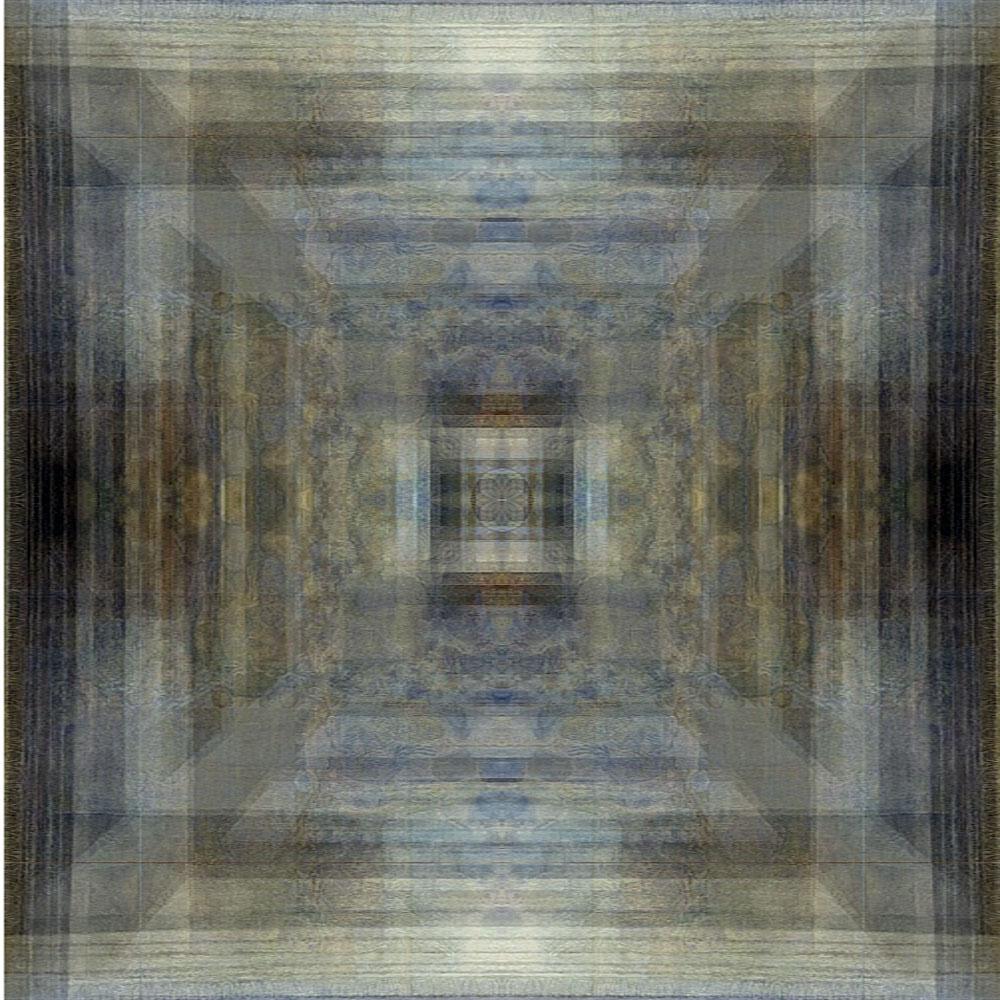
TRY THIS!
Get a picture of The Mona Lisa, then hold it up in front of your face so it covers up your entire field of view. Don’t look at the picture but imagine you’re looking at something in front of you (as if you’re looking through the picture). Now slowly move the picture back as if it’s on the back of a snail. You’ll want to go fast but don’t. Just be patient and keep looking past the picture as you move it back. Eventually you’ll get to your arm’s length. What did you see? Did you perceive anything new?
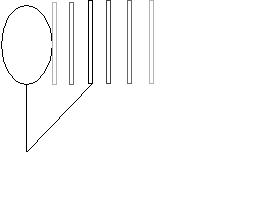
You might have to do it a couple times before you can keep yourself from focusing on anything. Imagine it’s not there and don’t try to see anything in particular– just look forward and try not to focus – you’ll notice that the picture will turn into two images but then eventually come together as you extend your hands. That’s how you really see things but your brain will combine them together. That’s how we can be “tricked” into seeing things. If you know how eyes work then you can manipulate them. An image can be designed to appear to move even though it is not.
Now try doing the opposite by bringing it towards you. Then try doing it with one eye covered at a time. THEN try to do it with your eyes focused on her.. but here’s the real question. Where do you focus?
Think about it. When you’re looking at someone where do you look? Into their eyes? At their mouth? If you said eyes – then which one? The right or the left? Hmmm – what about both at the same time? You’ll REALLY notice this when you talk to someone who has something in their teeth or on their face – you’ll actually try NOT to focus on it or you won’t be able to stop yourself. What makes you able to see something in its entirety vs it’s parts? Everything is the sum of its parts but at what point do you see the whole? Is it when you see something from far away or can you do the same thing up close?
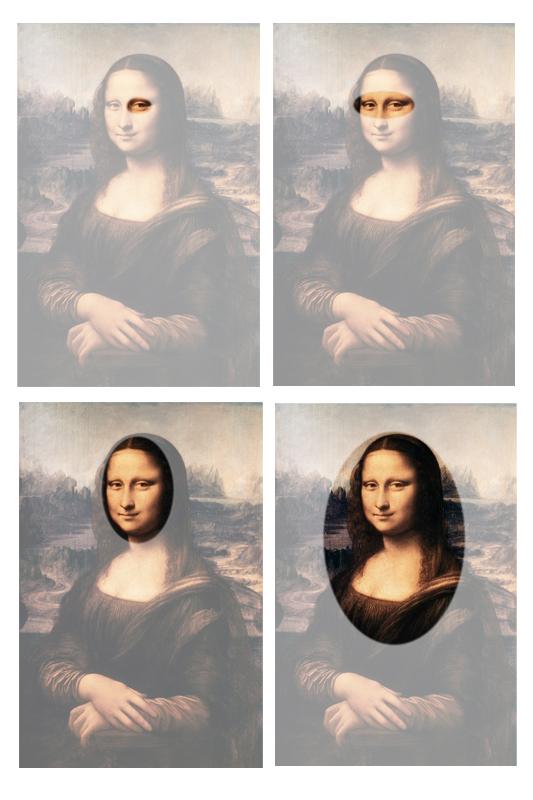
Where do you look? Each part or the whole? Why?
Hold the picture up again and look at it. Where do you first look? Her eyes? The center of the picture? Why? Now try to look at just one eye. Try looking at it as you move the picture around and away from you and towards you. Now try to look at both of her eyes at the same time. Can you do it? If you can’t keep moving it around until you can.
You have to believe that you can before you will or your brain will prevent you. It’s akin to how the Native Americans couldn’t see the pilgrim’s ships at first. They couldn’t imagine or perceive them because they were so unfamiliar. Similar to how babies can’t imagine a ball going under something. It’s a matter of perspective and we can’t see what we can’t perceive. Think of “where’s Waldo” Why can’t you just see him right away? It’s because you’re looking for him in small details. That’s how camouflage works – your eye doesn’t focus on something because everything looks the same. BUT if you were to be able to recognize what the unnatural pattern was – you could see it right away.
Our eyes are VERY sophisticated but only in terms of what we know how to perceive and know what to focus on. Without memory and paintings/photography the world would be a very different place. I think if Da Vinci were alive today he would be a director or a photographer. In a way that’s what he was. He created such realistic paintings and drawings it’s almost as if he was a human camera!
The following is an example of perception. This is important to realize before you can fully understand what the Mona Lisa truly is and how what you’re about to see could be possible. Remember also, just because you can’t do it (yet) or don’t believe it’s true doesn’t have anything to do with it being true or not. You just can’t comprehend it; once you can you just might find yourself looking at everything differently! With a new perception and from a new perspective…
The Shaman’s Sight
The shaman thought there was something different in the distance. He didn’t know what it was so he kept looking. Day after day after day until it became more and more clear to him. The ship started off as a spec but as it approached it started to change. He couldn’t understand what it was? Was it a bird? A whale? What could it be? So he kept watching and watching and as it got closer he was more and more confused. It appears to be made of wood, but what could have made something so large?
If you looked out from a cliff out into an ocean you’ve never seen before- how would you know if a small brown dot of a ship in the distance was meant to be there or not? How would you know if it’s moving? You would have to know what a ship is AND look long enough to see that it’s changing. The shaman could eventually see it and perceive it as something moving but it was so difficult because he had never seen anything like it before. He had to show the other Indians before they could even see it! Think about that and how it relates to The Mona Lisa and a lot of things in life. I believe Da Vinci was like that shaman Indian but wasn’t able to tell his tribe at the time because they were ignorant fools! You might know the feeling. I sure do.
Like those Indians we only know what we’ve been told or what we can expect to see. If it’s something new or different we might not even be able to notice it. That also explains why everyone reacts to new things with fear – we can’t let our guard down until we know it’s not going to hurt us. How could you know if you don’t even know what it is?
You can imagine how a peaceful tribe of Indians would try to kill any new settlers who came on a big arch in the ocean! They looked different but in a way that they had never seen! They either thought they were gods or devils – or whatever that particular person had experienced to help them identify these new “people”. This is also the root of fear and discrimination. After all what separates those Indians from someone who’s never left their house? How about the Quakers? They’re not crazy they just don’t get out much – literally. What would happen to their perception of the world if they did? They have a limited perspective..
The world is so vast and so full of wonder it’s a shame to stay in one place for too long. It’s best to live a life with open minds and eyes filled with beauty. Da Vinci said it best with this quote:
“The water you touch in a river is the last of that which has passed and the first of which is coming. Thus is it with time present. Life, if well spent, is long”
Meaning; Living in the present and appreciating it more than the past and future will give you a life worth living and all the time you could ever want or need. Learning to be patient can allow you to do almost anything.
Perspective in the Mona Lisa:
Why it’s off?
It’s always been a mystery as to why the perspective in the background seems to go off course behind Mona. Meaning that it’s not horizontally even. I actually figured this one out without knowing it, and then again randomly.
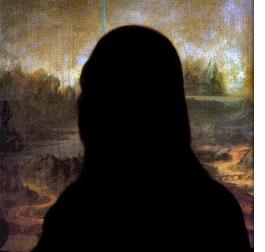
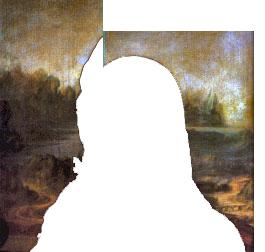
I had created the image on the next page months ago but I didn’t notice then that the edges matched up. It wasn’t until I rolled up a print out of the Mona Lisa that I noticed they aligned.
TRY IT!
You can do it yourself; Roll up a picture of the Mona Lisa, you’ll see how the edges of one side match up with the edges of the other. Why? How? Obviously you can’t roll up the real Mona Lisa – she’s painted on wood. This is very interesting because he would have had to design the painting to do this and also anticipate that someone could duplicate the Mona Lisa on a surface that could be rolled up. He couldn’t have expected someone to roll up a painting that’s on wood.
There is something else that is even more interesting and I think was a clue for someone to figure this out.
The painting originally had pillars on each side of Mona. The bottom of these can be seen on the sides. I actually thought they were vases at first or half circles that made me think they needed to join together. When I read that they were really remnants of pillars it made me question why anyone would remove them?
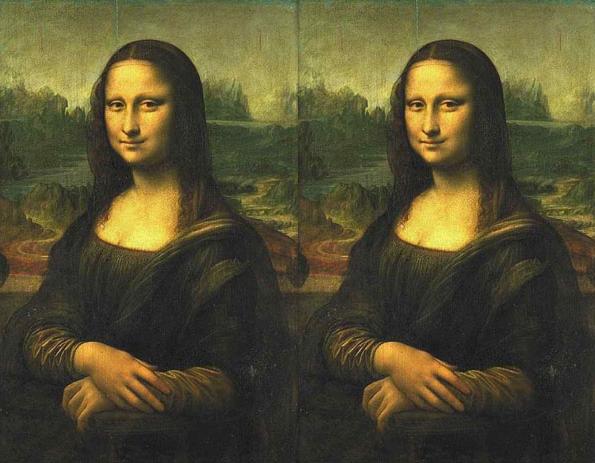
When Da Vinci died they cut the pillars off. No one knows why? Weird isn’t it? I think they did this because Da Vinci told them too. I think it was a clue to get people asking questions and trying to figure out why the perspective was off. When the pillars were there the perspective might not have even been noticed. They created a visual frame around the painting and obviously the edges wouldn’t match up if they remained. I also have a hunch that the use of a cylinder mirror might do something!
The Mona Lisa was designed to be “figured out” like a really complicated puzzle.
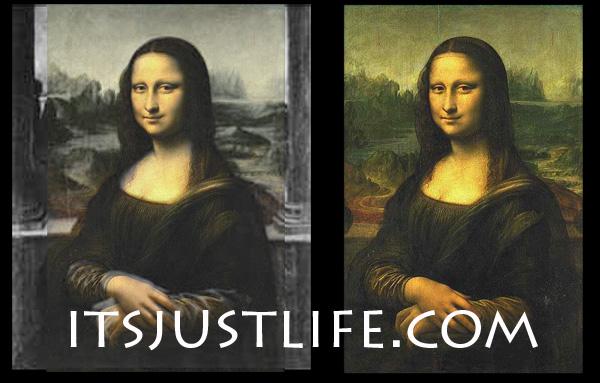
As far as I know and have read I’m the first to realize the sides match up – especially when rolled up. When the painting is made into a circle the edges match up even better than they do in the picture. Try it for yourself!
I still remember the first time I tried to roll up the painting and saw that the edges aligned. I was like “wow, maybe I’m not crazy after all!” It was a great moment because it was something that solidified that I wasn’t just imagining things. I discovered something no one else had. (at least that I’m aware of) Something that helped to confirm everything I was thinking about. It let me know I was on the right path.
Another thing very interesting about this is that it appears that Da Vinci planned for certain things to happen that would help someone put this together. This was only one thing he left behind as guidance.
The Divine Proportion:
To leave out the most interesting proportion of all in a chapter on perspective would be wasted. The process of life can be divided into a curious number whose presence makes even the most rigid scientist question the idea of a God, or a creative designing force behind existence. It’s called the divine proportion, the golden ratio – a relation between two things that begs questions. How & why? Dna, claws, horns, flowers, galaxies, all following the same proportion. Could it just be a coincidence or something more? I think of it as something akin to “the path of least resistance” if you wonder why something is the way it is, it’s that way (usually) because it was the best way of doing it. Why did they build the ancient Greek temples the way they did? What gives it its innate beauty? Why does a bee hive follow this proportion as well? Simply – because it’s best. Why build a hive that’s random and disorderly? Is this just a magic number or just a means to an end?
Maybe after trying things in as many ways as possible, there is a way, a path, which becomes the ideal way. The path of least resistance, the way which leads to where you want to go – the shortest route. The best design, the least superfluous. Think of the divine proportion as the IKEA of natural design. It’s the clean and simple lines, the beauty of simplicity but also the organized structure of chaos. It’s the patterns you notice in something random. Mathematically speaking it’s;
AB/ BC = CB/AC = 1.618
If you have a line that’s divided at a point somewhere between the two ends, the divine proportion is the segments division that equals = 1.618… The hand divided by the arm. The finger divided by the hand = very close to this ratio. There are plenty of examples of this but not too many explanations. I think it’s just breaking down the “best” way mathematically. Like a bell curve in a way. It’s the best way to do something. Interesting, the Fibonacci series, which is the two previous numbers added together eventually makes 1.618 as well. 377/233=1.618
1 . 2 . 3 . 5 . 8 . 13 . 21 . 34 . 55 . 89 . 144 . 233 . 377
This ratio can also be found in the design of the Great Pyramids and ancient Greek architecture. They most likely used it instinctually rather than knowing the math. In the case of the Pyramids I think it goes to show what I mean when I say it’s the “best” way of building something. They didn’t realize they were designing using this ratio – it’s just that they tried to design using the “best design possible” – the most efficient, which “coincidentally” is the divine proportion.
I could find you much more things that are related and point out people such as Derek Bair who all have some fruits of the tree, but at this point they also get lost very easily as pride takes over and they seek in their own findings the whole, and they start to add ideas which only finds grounding in their mind.
Yet all these findings should not be taken as a personal achievement.
Heb 4 :12 The holy spirit will teach you all things, the word of g-d is living and active, it penetrates even to the dividing of soul and spirit. It judges the thoughts and habits of the heart.
Remember that this focusing on external things even if they are fruits, are still fruits of the tree of knowledge, and yes his wisdom is in the seeds, even in that of the mustard seed, but your believe hasn’t reached that size yet if you still need to find more of it in the external, as this clearly shows Mr. Bucket is still in control.
Yes he gave your free will, but you do not realize that you sold your heart to Him, and therefore do not have free will…yet.
You are used to a life filled with variation and have been educated to differentiate, which also led to the different languages, religion’s etc.
Is it not about time to find what connects? Instead of trying to satisfy ego/some part of personality, start being what you know to be true, and truth will come to you, a whole mountain of it.
It is a matter of perspective, you either look from the center and see the whole, or you try to find your center in everything which in truth is not your center at all but His.
08-08-2007
Moshiya van den Broek
Based upon work by Derek Bair



